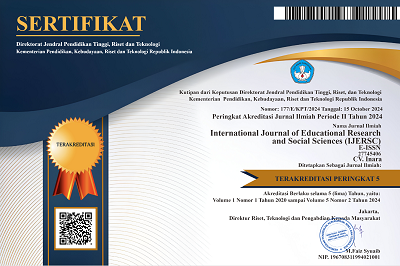The Development Of Correctional System Of Narcotic And Prohibited Drugs Using The Criminon Program At Cipinang Narcotics Special Penitentiary
DOI:
10.51601/ijersc.v4i4.695Published:
2023-08-30Downloads
Abstract
Broadly speaking, coaching at the Narcotics Special Penitentiary has the same goal,
namely to rehabilitate convicts so that they become good and law-abiding citizens.
However, in the implementation of coaching, there are still obstacles that cause the
coaching program to not run effectively. This research is aimed at answering
questions related to the implementation of fostering narcotics case convicts at the
Narcotics Special Penitentiary and what are the obstacles encountered in the
implementation of coaching for narcotics case convicts. This is a research that uses
the library research method but the data collection is also complemented by semistructured interviews with drug case convicts, coaching program instructors and
also officials responsible for coaching program licenses. The results of the study
indicate that the implementation of the program for fostering convicts of narcotics
cases using the Criminon method cannot be said to be effective. This can be seen
from a number of obstacles encountered during program implementation. These
obstacles are not only in the program, but also in the inmates who are coached and
the instructors who do not understand the theories of the Criminon program.
References
Arif, Gosita. (1993). Masalah Korban Kejahatan (Kumpulan Tulisan). Ed. Ketiga. Jakarta: Bhuana Ilmu
Populer.Hal.6.
Atmasasmitha, Romli. (1992). Teori & Kapita Selekta Kriminolog, Bandung, PT. Eresco.
Badan Narkotika Nasional. (2003). Pedoman Pencegahan Penyalahgunaan Narkoba. Jakarta: BNN. Hal. 40-42.
Bemmelen, Mr. J.M. van, (1987) . Hukum Pidana 1, Hukum Pidana Materiil. Bandung: Binacipta.
Departemen Kehakiman dan Hak Asasi Manusia, Direktorat Jenderal Pemasyarakatan. (2004). Himpunan
Peraturan Perundang-Undangan Tentang Pemasyarakatan. Jakarta: Departemen Kehakiman dan Hak Asasi
Manusia RI. Hlm. 69-70.
Hamzah, Andi dan Siti Rahayu. (1983). Suatu Tinjauan Ringkas Sistem Pemidanaan Di Indonesia. Ed.I. Jakarta:
Akademika Pressindo. Hlm. 97
Hubbard. L. Ron. (1991). Criminon Therapeutic TRs Course. Los Angeles: Association For Better Living and
Education. Hlm. 3.
Hubbard. L. Ron. (1991). Learning Improvement Course. Los Angeles: Association For Better Living and
education. Hlm. 17.
Muladi. (2004). Kapita Selekta Sistem Peradilan Pidana, Cet. 2. Semarang: Penerbit Universitas diponegoro.
Hal. 2.
Panjaitan, Petrus Irwan dan Pandapotan Simorangkir. (1995). Lembaga Pemasyarakatan Dalam Sistem
Peradilan Pidana. Jakarta: Pustaka Sinar Harapan. Hal. 12.
Sihabudin. (2006). “ Napi Narkotika Perlu Terapi Khusus”, Figur. Ed. III/Thn. 2006. Hal. 20.
Sugiyono. (2010). Metode Penelitian Pendidikan Pendekatan Kuantitatif, kualitatif, dan R&D. Bandung:
Alfabeta.
Sugiyono. (2013). Metode Penelitian Kuantitatif, Kualitatif dan R&D. Bandung: Alfabeta.CV.
Sudarsa, Agun Gunanjar. (2006). Say No To Drugs. Figur. Ed. V/ Th. 2006. Hal 3.
(2006). Waspadai Anak-anak Dari Jaringan Narkoba, Figur. Ed. III/Th. 2006. Hal 23.
(2006). Dunia Belajar Criminon di Indonesia. Figure. Ed III/Th. 2006. Hal 13.
Laws Decree of the Minister of Justice Number: M.02-PK.04.10 of 1990, concerning Patterns of Development of
Convicts/Detainees Law Number 12 of 1995 concerning Corrections.
License
Copyright (c) 2023 International Journal of Educational Research and Social Sciences (IJERSC)

This work is licensed under a Creative Commons Attribution 4.0 International License.






